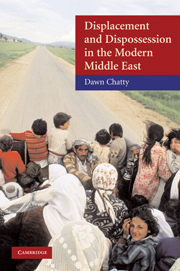Book contents
- Frontmatter
- Contents
- List of Tables
- List of Charts and Maps
- Acknowledgements
- Introduction: Dispossession and Forced Migration in the Middle East: Community Cohesion in Impermanent Landscapes
- 1 Dispossession and Displacement within the Contemporary Middle East: An Overview of Theories and Concepts
- 2 Dispossession and Forced Migration in the Late Ottoman Empire: Distinct Cultures and Separated Communities
- 3 Circassian, Chechnyan, and Other Muslim Communities Expelled from the Caucasus and the Balkans
- 4 The Armenians and Other Christians: Expulsions and Massacres
- 5 Palestinian Dispossession and Exodus
- 6 Kurds: Dispossessed and Made Stateless
- 7 Liminality and Belonging: Social Cohesion in Impermanent Landscapes
- Bibliography
- Index
4 - The Armenians and Other Christians: Expulsions and Massacres
Published online by Cambridge University Press: 05 June 2012
- Frontmatter
- Contents
- List of Tables
- List of Charts and Maps
- Acknowledgements
- Introduction: Dispossession and Forced Migration in the Middle East: Community Cohesion in Impermanent Landscapes
- 1 Dispossession and Displacement within the Contemporary Middle East: An Overview of Theories and Concepts
- 2 Dispossession and Forced Migration in the Late Ottoman Empire: Distinct Cultures and Separated Communities
- 3 Circassian, Chechnyan, and Other Muslim Communities Expelled from the Caucasus and the Balkans
- 4 The Armenians and Other Christians: Expulsions and Massacres
- 5 Palestinian Dispossession and Exodus
- 6 Kurds: Dispossessed and Made Stateless
- 7 Liminality and Belonging: Social Cohesion in Impermanent Landscapes
- Bibliography
- Index
Summary
My native family name is Vosgueritchian. It means goldsmith, because my grandfather had been a goldsmith in Severeg, which is in Western Armenia. My grandfather had been part of a large family. He had four sisters and a brother, but they are all gone, he was the only survivor. He reached Egypt after a very long journey. He came by himself. He found work and he built himself up. He had lost his entire family when he was very young. He was in an orphanage. One day when they needed to decide his age, they lined him up with other boys and put the back of the spoon in his mouth and a doctor passed around looking at the teeth of the boys and say, he is nine years old, for example. This is how they decided his age and said he must have been born in 1905. He left Severeg in 1915 with his whole family. There had been many disturbances and one night the doorbell rang at the house and there were wagons. The whole family went but he and his brother was taken in by a Turkish family and saved on that occasion. Later, he and his brother had to join the marches and his brother died on the road. He arrived in Aleppo alone and was taken into an orphanage. He remained there a few years and then in 1918 he left the orphanage to go back and volunteer to be a soldier [for Turkish independence]. By 1923 he was in Constantinople [Istanbul] with four friends who had also fought with him. […]
- Type
- Chapter
- Information
- Displacement and Dispossession in the Modern Middle East , pp. 134 - 179Publisher: Cambridge University PressPrint publication year: 2010

